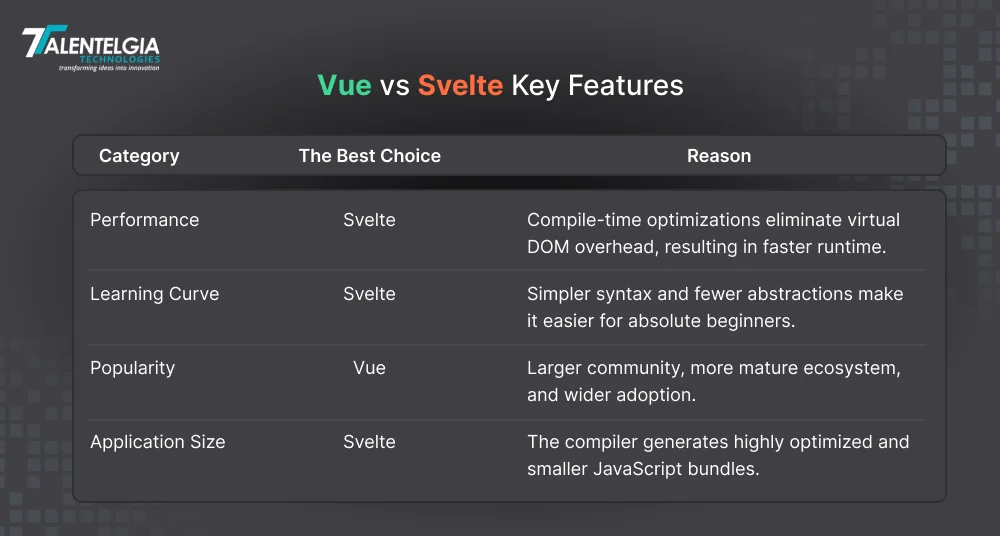If you are building a modern web application, then the Vue vs Svelte debate probably has come across your screen. Both have superb performance and development ease but take entirely different approaches. Svelte differs in that it compiles code as optimally generic JavaScript, while Vue uses a reactive, component-based structure. So which one are you going to pick?
Let us discuss more about both Vue and Svelte to help you make your decision.
What is Vue?
Vue.js is a modern JavaScript framework used for creating user interfaces and single-page applications. Vue is a progressive JavaScript framework created by Evan You. It follows a declarative and component-based programming approach to build interactive UIs. Like React, it is efficient in updating only the part of the application that has been changed as it uses virtual DOM. While its Options API and Composition API provide developers the freedom to code differently.
Key Features of Vue
- Reactive data binding
- Efficient rendering with Virtual DOM
- Architecture based on components
- Built-in state management (Vuex, Pinia)
- Large ecosystem (with packages such as Vue Router and Vuex
- Two-way data binding
- Strong TypeScript support
What is Svelte?
Svelte is a relatively new front-end framework that works differently for building web applications. In contrast, Svelte compiles components into highly optimized JavaScript during the build process instead of using a virtual DOM. This gives no runtime updates and leads to better performance smaller bundles, and less boilerplate. Svelte — which was developed by RichHarris simplifies front-end development by eliminating needless complexity.
Key Features of Svelte
- Build time functional code (no virtual DOM)
- More readable and simpler syntax
- Minimal boilerplate code
- Built-in state management
- Reactive dispatchers for automated refresh
- Smaller bundle sizes
Vue vs Svelte — Key Features
Essential features to compare when choosing between Vue vs Svelte Both frameworks are highly capable and modern solutions for building web applications. But they differ when it comes to reaching performance and simplicity goals.
Vue has a structured ecosystem, reactivity, and component-based architecture. Similarly Svelte removes the virtual DOM, compiling component templates as highly efficient JavaScript at build time. Now, let’s move on to the meat of the matter and compare the essential aspects of Vue vs Svelte, what makes them different, and the implications on development.

1. Performance
Performance is an important consideration when choosing a front-end framework. While Vue is similar to React as it uses a kind of virtual DOM, it can update the components that have changed based on the existing data.
On the other hand, Svelte eliminates virtual DOM by compiling its components to highly efficient JavaScript. This leads to faster rendering and better runtime performance. When compared with Vue, the applications made with Svelte occupy less memory and take less execution time.
Which one is better? Compile-time optimizations give Svelte an edge when it comes to raw performance.
2. Learning Curve
Vue is ideal for beginners with a lower learning curve and simple documentation. It provides both Options API and Composition API, so developers can select a coding style that works best for them.
Even though Svelte has many different features than other libraries it follows the standard JavaScript syntax. So there are no additional state management libraries or tooling setups needed to get started. It has a simple syntax and a simple way of writing, reading, and debugging the code.
Which one is better? Due to its simple syntax, Svelte is a beginner-friendly choice, but Vue is also easy to learn with extensive documentation and community support.
3. Popularity
Vue has been around for longer, with a massive ecosystem, including widely used libraries such as Nuxt. js for server-side rendering. It has a rich community and has been adopted by companies such as Alibaba, Xiaomi, GitLab, and many more.
Svelte is a relatively new framework that has a smaller community and ecosystem than Vue, though it is rapidly gaining popularity. Although it continues to get more popular, Vue is still the more common production application.
Which one is better? Vue wins on community adoption and ecosystem maturity.
Svelte users report high satisfaction levels.
4. Application Size
Due to the framework’s runtime dependencies, Vue applications have a greater bundle size. While tree-shaking and other optimization techniques are used to reduce the final build size, Vue applications introduce some overhead.
Since Svelte is a compiler-based framework, it generates smaller and more optimized JavaScript bundles. Svelte applications are very small in size (compared to typical web applications).
Which one is better? Svelte produces smaller application sizes and more optimized output.
Vue vs Svelte — Comparison
Many factors like performance are important to be considered when comparing Vue vs Svelte. While both frameworks aim for fast performance, they approach this goal in different ways. For handling updates, Vue uses a virtual DOM, making it efficient for large applications. Unlike React, Svelte does not use a virtual DOM, instead, it compiles your components to perfect, imperative JavaScript. This difference affects load time, memory, and runtime performance. Let’s now dive into Vue vs Svelte performance, examining how the two frameworks manage updates, rendering, responsiveness, and performance in the wild.
Pros and Cons of Vue and Svelte
| Feature | Vue | Svelte |
|---|---|---|
| Performance | Uses virtual DOM, optimized but slower | Compiles to JavaScript, extremely fast |
| Learning Curve | Easy to learn with extensive docs | Simpler syntax, easier for beginners |
| Popularity | Large community, a strong ecosystem | Growing community, fewer third-party tools |
| Application Size | Larger due to runtime dependencies | Smaller due to compilation |
| State Management | Vuex, Pinia | Built-in reactive stores |
| Ecosystem | Extensive libraries, Nuxt.js support | Less mature but improving |
Use Cases: Vue vs Svelte
When deciding Vue vs Svelte, it all comes down to what your project needs. Both frameworks provide efficient development and modern features, but they are best suited for different situations. Due to its mature ecosystem and supportive community, Vue is designed for enterprise applications that need a long-term maintenance application. Conversely, Svelte offers great implementations for apps that require executive speed and minimal bundle size (since it compiles the app at build time). Here are some of the best use cases for Vue vs Svelte, so you can decide which framework is most closely aligned with your development goals.
1. MobileApp Development: For mobile app development, you can go for Vue. It has a mature ecosystem along with frameworks such as Vue Native and Quasar. While Svelte is very efficient, there are no dedicated frameworks to support mobile.
Best Choice: Vue
2. IoT Applications: Svelte is the preferred product if you’re developing an IoT application where performance and size are important. The code is compiled into a lightweight thing that is efficiently runnable on low-power devices.
Best Choice: Svelte
3. Serverless Architecture: Svelte’s smaller bundles make it perfect for a serverless application, where getting cold start time down is critical.
Best Choice: Svelte
4. AI & ML Integration: Vue is compatible with most ML and AI libraries such as TensorFlow. js. Svelte’s ecosystem does not provide good support for AI development services.
Best Choice: Vue
Conclusion
Both Vue and Svelte have some strengths that make them strong competitors in front-end development. The right choice will vary depending on your project requirements.
If you need a more mature framework regarding the ecosystem, community support, and years, if you want a good compromise between performant and scalable, Vue is the winner. This, combined with its well-structured design, extensive plugin system, and ability to be integrated with applications already in development gives it a smoother transition for enterprises and larger implementations.
But if you are very serious about performance complexity and footprint, then Svelte is the library for you. Its compiler-based approach eliminates the virtual DOM, enabling much faster rendering and smaller bundles. This is why it is perfect for lightweight applications and for startups and projects, that have to be at maximal speed.
So the right tool for your use case depends heavily on your project complexity, your team's familiarity, and the desired future extensibility of your code base. Since use-case-specific tools come with their advantages, their application is limited to a small set of moving parts.
Need expert guidance to build a high-performance web application? Our experienced developers specialize in both Vue and Svelte, helping businesses create scalable, efficient, and future-ready solutions. Get in touch with us today and let’s bring your vision to life!


 Healthcare App Development Services
Healthcare App Development Services
 Real Estate Web Development Services
Real Estate Web Development Services
 E-Commerce App Development Services
E-Commerce App Development Services E-Commerce Web Development Services
E-Commerce Web Development Services Blockchain E-commerce Development Company
Blockchain E-commerce Development Company
 Fintech App Development Services
Fintech App Development Services Fintech Web Development
Fintech Web Development Blockchain Fintech Development Company
Blockchain Fintech Development Company
 E-Learning App Development Services
E-Learning App Development Services
 Restaurant App Development Company
Restaurant App Development Company
 Mobile Game Development Company
Mobile Game Development Company
 Travel App Development Company
Travel App Development Company
 Automotive Web Design
Automotive Web Design
 AI Traffic Management System
AI Traffic Management System
 AI Inventory Management Software
AI Inventory Management Software
 AI Software Development
AI Software Development  AI Development Company
AI Development Company  AI App Development Services
AI App Development Services  ChatGPT integration services
ChatGPT integration services  AI Integration Services
AI Integration Services  Generative AI Development Services
Generative AI Development Services  Natural Language Processing Company
Natural Language Processing Company Machine Learning Development
Machine Learning Development  Machine learning consulting services
Machine learning consulting services  Blockchain Development
Blockchain Development  Blockchain Software Development
Blockchain Software Development  Smart Contract Development Company
Smart Contract Development Company  NFT Marketplace Development Services
NFT Marketplace Development Services  Asset Tokenization Company
Asset Tokenization Company DeFi Wallet Development Company
DeFi Wallet Development Company Mobile App Development
Mobile App Development  IOS App Development
IOS App Development  Android App Development
Android App Development  Cross-Platform App Development
Cross-Platform App Development  Augmented Reality (AR) App Development
Augmented Reality (AR) App Development  Virtual Reality (VR) App Development
Virtual Reality (VR) App Development  Web App Development
Web App Development  SaaS App Development
SaaS App Development Flutter
Flutter  React Native
React Native  Swift (IOS)
Swift (IOS)  Kotlin (Android)
Kotlin (Android)  Mean Stack Development
Mean Stack Development  AngularJS Development
AngularJS Development  MongoDB Development
MongoDB Development  Nodejs Development
Nodejs Development  Database Development
Database Development Ruby on Rails Development
Ruby on Rails Development Expressjs Development
Expressjs Development  Full Stack Development
Full Stack Development  Web Development Services
Web Development Services  Laravel Development
Laravel Development  LAMP Development
LAMP Development  Custom PHP Development
Custom PHP Development  .Net Development
.Net Development  User Experience Design Services
User Experience Design Services  User Interface Design Services
User Interface Design Services  Automated Testing
Automated Testing  Manual Testing
Manual Testing  Digital Marketing Services
Digital Marketing Services 
 Ride-Sharing And Taxi Services
Ride-Sharing And Taxi Services Food Delivery Services
Food Delivery Services Grocery Delivery Services
Grocery Delivery Services Transportation And Logistics
Transportation And Logistics Car Wash App
Car Wash App Home Services App
Home Services App ERP Development Services
ERP Development Services CMS Development Services
CMS Development Services LMS Development
LMS Development CRM Development
CRM Development DevOps Development Services
DevOps Development Services AI Business Solutions
AI Business Solutions AI Cloud Solutions
AI Cloud Solutions AI Chatbot Development
AI Chatbot Development API Development
API Development Blockchain Product Development
Blockchain Product Development Cryptocurrency Wallet Development
Cryptocurrency Wallet Development About Talentelgia
About Talentelgia  Our Team
Our Team  Our Culture
Our Culture 
 Healthcare App Development Services
Healthcare App Development Services Real Estate Web Development Services
Real Estate Web Development Services E-Commerce App Development Services
E-Commerce App Development Services E-Commerce Web Development Services
E-Commerce Web Development Services Blockchain E-commerce
Development Company
Blockchain E-commerce
Development Company Fintech App Development Services
Fintech App Development Services Finance Web Development
Finance Web Development Blockchain Fintech
Development Company
Blockchain Fintech
Development Company E-Learning App Development Services
E-Learning App Development Services Restaurant App Development Company
Restaurant App Development Company Mobile Game Development Company
Mobile Game Development Company Travel App Development Company
Travel App Development Company Automotive Web Design
Automotive Web Design AI Traffic Management System
AI Traffic Management System AI Inventory Management Software
AI Inventory Management Software AI Software Development
AI Software Development AI Development Company
AI Development Company ChatGPT integration services
ChatGPT integration services AI Integration Services
AI Integration Services Machine Learning Development
Machine Learning Development Machine learning consulting services
Machine learning consulting services Blockchain Development
Blockchain Development Blockchain Software Development
Blockchain Software Development Smart contract development company
Smart contract development company NFT marketplace development services
NFT marketplace development services IOS App Development
IOS App Development Android App Development
Android App Development Cross-Platform App Development
Cross-Platform App Development Augmented Reality (AR) App
Development
Augmented Reality (AR) App
Development Virtual Reality (VR) App Development
Virtual Reality (VR) App Development Web App Development
Web App Development Flutter
Flutter React
Native
React
Native Swift
(IOS)
Swift
(IOS) Kotlin (Android)
Kotlin (Android) MEAN Stack Development
MEAN Stack Development AngularJS Development
AngularJS Development MongoDB Development
MongoDB Development Nodejs Development
Nodejs Development Database development services
Database development services Ruby on Rails Development services
Ruby on Rails Development services Expressjs Development
Expressjs Development Full Stack Development
Full Stack Development Web Development Services
Web Development Services Laravel Development
Laravel Development LAMP
Development
LAMP
Development Custom PHP Development
Custom PHP Development User Experience Design Services
User Experience Design Services User Interface Design Services
User Interface Design Services Automated Testing
Automated Testing Manual
Testing
Manual
Testing About Talentelgia
About Talentelgia Our Team
Our Team Our Culture
Our Culture

















 Write us on:
Write us on:  Business queries:
Business queries:  HR:
HR: 




